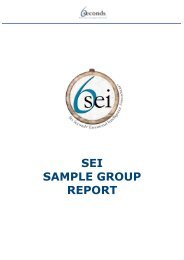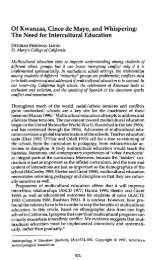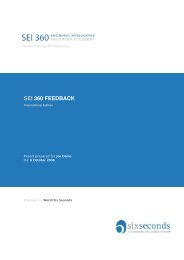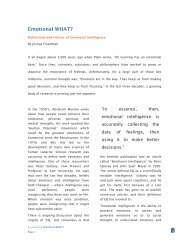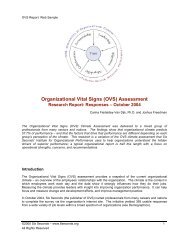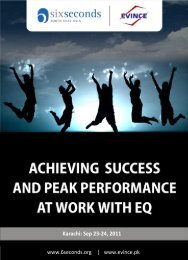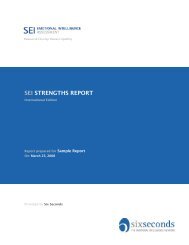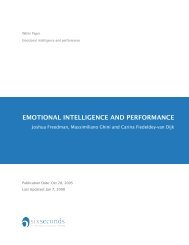The Emotional Literacy Museum - Six Seconds
The Emotional Literacy Museum - Six Seconds
The Emotional Literacy Museum - Six Seconds
- No tags were found...
You also want an ePaper? Increase the reach of your titles
YUMPU automatically turns print PDFs into web optimized ePapers that Google loves.
<strong>The</strong> <strong>Emotional</strong> <strong>Literacy</strong> <strong>Museum</strong>Introduction<strong>The</strong> <strong>Emotional</strong> <strong>Literacy</strong> <strong>Museum</strong> is a self-directed learningexperience teaching about the physiology of emotions, emotionalregulation, and emotional literacy.<strong>The</strong> <strong>Emotional</strong> <strong>Literacy</strong> <strong>Museum</strong> was developed byJoshua Freedman, Director, <strong>Six</strong> <strong>Seconds</strong> Institute for Organizational PerformanceAnabel Jensen, Ph.D., President, <strong>Six</strong> <strong>Seconds</strong>Marsha Rideout, Director of Instruction, <strong>Six</strong> <strong>Seconds</strong>with contributions fromTodd Everett, MBA, Organizational Programs Manager, <strong>Six</strong> <strong>Seconds</strong>Tom Wojick, MA, Senior Consultant, <strong>Six</strong> <strong>Seconds</strong>and thanks toDavid Caruso, Ph.D., for inspiration for several exercises©2006 <strong>Six</strong> <strong>Seconds</strong>, www.6seconds.org/museum staff@6seconds.org
Introduction<strong>The</strong> <strong>Emotional</strong> <strong>Literacy</strong> <strong>Museum</strong> is a dynamic, engaging, learner-driven tool that teachesone of the foundational skills of emotional intelligence.<strong>Emotional</strong> <strong>Literacy</strong> is recognizing, naming, and understanding feelings. Feelings have“rules,” and by learning the basic “moves” emotions can make, their causes and effects,and the ways they combine, people have a much easier time managing feelings. At a basiclevel, simply naming a feeling sooths the limbic brain’s activity related to the feeling – asif that part of the brain says, “Ok! Now you understand me.”<strong>The</strong> training package includes acomplete <strong>Emotional</strong> <strong>Literacy</strong><strong>Museum</strong> and courseware for a ½-dayinteractive training. <strong>The</strong> packageincludes a CD with Powerpoint®slides and speaker notes, a handout,and masters for reproducing itemsneeded for the <strong>Museum</strong>.Objectives• Increased knowledge aboutemotions and how to learn about them.• More useful attitude toward emotions as something valuable and interesting.• Stronger skills in recognizing and managing feelings.Primary outcome: participants leave with an expanded awareness about emotions asuseful, neurobiological responses to the environment. In other words, they leave saying“emotions are real – and they have value.”Application<strong>The</strong> <strong>Emotional</strong> <strong>Literacy</strong> <strong>Museum</strong> is designed as self-guided learning process. <strong>The</strong>seinstructions describe a half-day workshop based on the <strong>Museum</strong>. <strong>The</strong> workshop iseffective for groups ranging from 8-24 participants; a larger group can be accommodatedwith two sets of the <strong>Museum</strong> stations. <strong>The</strong> curriculum has been field-tested with a widevariety of audiences in business, education, health, and government. It has worked wellwith participants from over a dozen different countries, and in all job levels.<strong>The</strong> components are highly versatile, so in addition to the stand-alone workshop thispackage can be used as a:• brief interactive session (30-60 minutes).• breaktime activity during a related training or conference.• lunch-and-learn experience.©2006 <strong>Six</strong> <strong>Seconds</strong>, www.6seconds.org/museum staff@6seconds.org
• interactive learning component to another event such as open house or learningday.In addition, the <strong>Museum</strong> can be segmented into a series of activities to intersperse withinother training.<strong>Museum</strong> Stations<strong>The</strong>re are many components in the <strong>Museum</strong>. Depending on space available and yourapplication, you may choose to use only some of the exercises. Each is identified as a“station” – like an exhibit in a real museum.Feeling CardsActivity: Sort cardsinto groups accordingto the emotion shownon the picture.Heart-Mind-Body*Activity: Take bloodpressure, read a newsarticle, then take blood pressure again.Tipples’ FacesActivity: Copy facial expressions bylooking in a mirror.Magnetic FacesActivity: Create an image of anemotional expression.Feeling PhotosActivity: Identify the emotionsconveyed in four photos.Inside/OutsideActivity: Depictfeelings experienced vsfeelings exhibited,discuss.Musical Feelings*Activity: Listen to music and expressthe feelings conveyed through sculpture.FreezeFramer*Activity: Use theHeartMath FreezeFramer® to graphheart rate variability.BiodotsActivity: Experiment with a Biodotstress monitor.EmotionometerActivity: Complete a worksheetshowing the gradations, or varyingintensities, of an emotion.EmotionFlowerActivity: Partners,identify andexplain theemotions.Moon FacesActivity: Identify the physical“symptoms” of various emotions.* Value-addedstations availablein addition to thebasic museum.©2006 <strong>Six</strong> <strong>Seconds</strong>, www.6seconds.org/museum staff@6seconds.org



